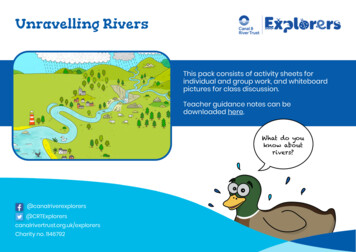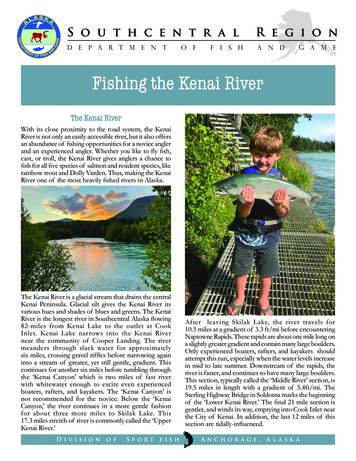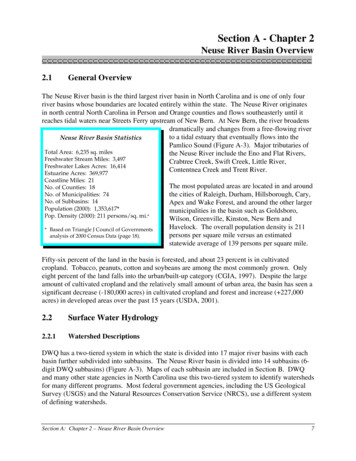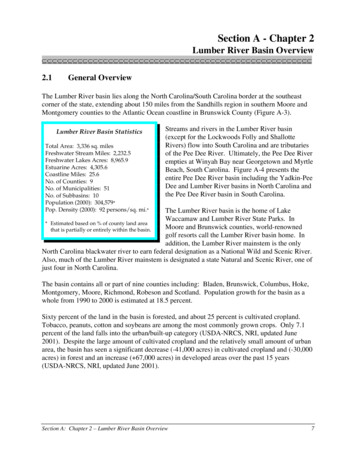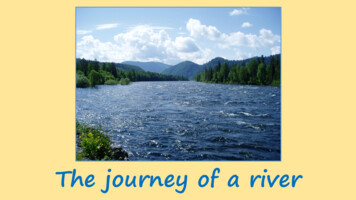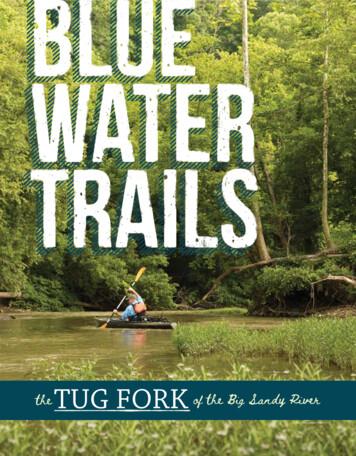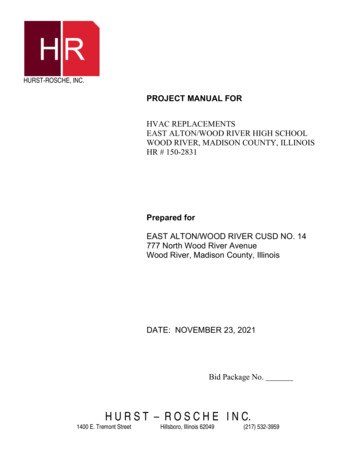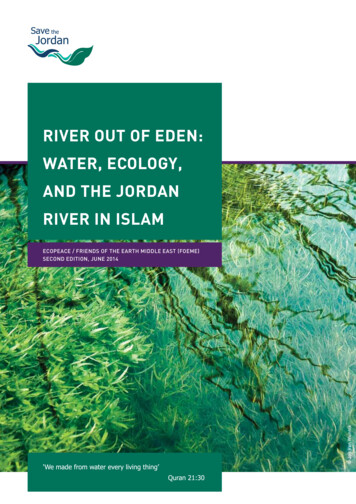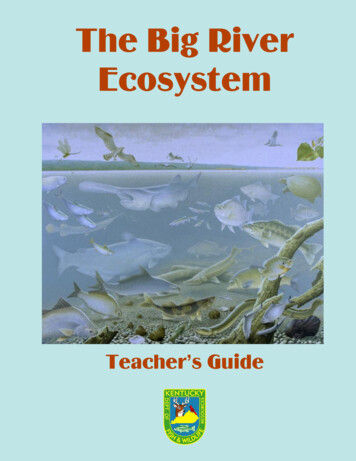
Transcription
The Big RiverEcosystemTeacher’s Guide1
INTRODUCTIONWelcome back to the aquatic world of R ick H ill. T his visit is not for the feint of heart northe weak swimmer. We are venturing into the exciting world of the B ig R iver: deep, mysterious, and home to big fish. We could put a specific river’s name on it but in essence it could beone of several rivers. Pick one; it may flow next to your town, your school, your home.B ig rivers are the end result of very large scale watersheds. Just as rainfall runs from theroof of our home or school, it is “shed” by the earth. T he rate it flows into streams is determined by degree of vegetative cover, slope of the land, and human land uses. E ach area whichdrains rainfall into a given stream is defined as that stream’s watershed. T herefore, a big river’swatershed includes all land which drains water into feeder streams and rivers which flow intothat river. T he M ississippi watershed is the largest of the U nited States as it includes that landmass which drain into the M issouri, O hio, Tennessee, and A rkansas rivers to name but a few.T he basic goal of the aquatic ecosystem poster ser ies is to educate all people onthe impor tance of healthy aquatic systems and their relationship to lifelong aquaticrecreation. T herefore, this guide will stress positive aspects of what we recognize as nationalbiological treasures. W hen students receive a negative picture of one portion of the environment, they may give up and look for something where their generation can make a difference.By informing and exciting them about “mysteries of the deep”, perhaps the rivers of K entuckywill be that environmental challenge they will want to answer. To maintain balance, a realitysection will be included to give teachers factual answers to anticipated questions about our bigrivers as we enter the 21st century.T here are four teaching sections in this teacher’s guide. First, each species featured on theposter is identified by common and specific name for users. Next, we establish large scalewatershed concepts and how each segment of a watershed contributes to the B ig R iver. T heancient fish section is intended to call attention to this unique group of fish and what is happening with them today. Finally, we illustrate human interactions with rivers and the economicimportance of these rivers to our nation.For K entucky teachers, at least one K E R A Academic E xpectation from K entucky’s C urriculum Framework has been included for each activity. T his is to illustrate the broad range ofexpectations that could be taught using individual activities or combinations. W hile oneexpectation is included, many others could be included. To improve our ecosystem efforts,please fill out the evaluation on the next page and return it to the address listed. Additionalteaching ideas are requested and will be included in future publications of this teacher’s guidewhen received. Send all comments to:A quatic E ducation A dministratorK Y D epartment of Fish and W ildlife R esources# 1 G ame Farm R d.Frankfort K Y 40601(502) 564-4762/FA X (502) 564-6508/e-mail lnelson@ mail.state.ky.us2
EVALUATIONName:School:Address:Grade taught:Phone:e-mail1. I received my Big River Ecosystem poster and teacher’s guide from the following source.2. On a scale of one to ten, please evaluate the poster in comparison to similar materials youhave received.123456789103. What did you like most or least about the poster to rate it as you did?4. How have you used this poster?5. On a scale of one to ten please evaluate the teacher’s guide you received in comparison to othersimilar products?123456789106. What did you like most or least about the teacher’s guide to rate it as you did?7. What other aquatic related materials would you find useful in your class or youth group?ADDITIONAL COMMENTS (PLEASE INCLUDE HERE ANY ACTIVITIES YOU HAVEDEVELOPED FROM THIS POSTER):I REQUEST THE FOLLOWING:Contact me with Project WILD training opportunities.Place me on a mailing list for future materials.Please send extra copies for teachers at my school.Other3
COMMON AND SPECIFIC NAMES,For position, refer to graphic on poster.COMMON NAME1. Midge2. Green darner dragonfly3. Osprey4. Ring-billed gull5. Black-crowned night heron6. Cottonwood7. Stonefly8. Burrowing mayfly9. Mooneye10. Skipjack herring11. Longnose gar12. River shiner13. Paddlefish14. Silver lamprey15. Emerald shiner16. White bass17. Smooth softshell turtle18. White crappie19. Threadfin shad20. Blue catfish21. Carp22. Spotted bass23. Dragonfly nymph24. Highfin carpsucker25. Blue sucker26. Shovelnose sturgeon27. Smallmouth buffalo28. Bluegill29. Midge larva30. Freshwater drum31. Armored rock snail32. Pointed campeloma snail33. River darter34. Butterfly mussel35. Crayfish36. Sauger37. Mapleleaf mussel38. American eel39. Silver chub40. Stonefly nymph41. Gizzard shad42. Burrowing mayfly nymph43. Washboard mussel4SPECIFIC NAMEChaoborus sppAnax juniusPandion haliaetusLarus delawarensisNycticorax nycticoraxPopulus deltoidesPteronarcys sppHexagenia sppHiodon tergisusAlosa chrysochlorisLepisosteus osseusNotropis blenniusPolyodon spathulaIchthyomyzon unicuspisNotropis atherinoidesMorone chrysopsApalone muticaPomoxis annularisDorasoma petenenseIctalurus furcatusCyprinus carpioMicropterus punctulatusAnax juniusCarpiodes veliferCycleptus elongatusScaphirrhynchops platyrrhynchusIctiobus bubalusLepomis macrochirusChaoborus sppAplodinotus grunniensLithasia armigeraCampeloma decisumPercina shumardiEllipsaria lineolataOrconectes rusticusStizostedion canadenseQuadrula quadrulaAnguilla rostrataHybopsis storerianaPteronarcys sppDorosoma cepedianumHexageniaMegalonaias gigantea
RaindropsKeep FallingOn My 'ShedE ach time rain or snow falls on K entucky,a contribution is made to a perpetual flowingsystem: T he M ississippi R iver Watershed. Toget there, resultant runoff water may takemany different paths through varied habitatsbut it all ends up in the M ississippi. A t first,it drips or oozes through vegetation, soil, oralong rocks. T hen water begins to flow in adepression which carries water only after thestorm. W hen these small rivulets meet andform a continually flowing stream, a “firstorder stream”, we have the beginning of ther iver continuum.T he M ississippi river watershed has literally thousands of these small streams whichcontribute to the flow. To find them you mustfind local maps such as topographic or countymaps. T he state or national maps will depictthe major systems but the first order streamsare too small to be shown on large scaledepictions.E very headwater stream in the watershedhas a unique “signature”. N utrients andsuspended vegetation are specific to that landmass. I nitially, there is little aquatic plantgrowth so the initial part of the food chaindepends on food that falls or is washed intothe stream. T his vegetative material is processed by animals, primarily insects such asstoneflies, called “shredder s”. Small particles which are not eaten by shredders areeaten by “collector s” i.e. mayflies. M ost fishthat live here are small predators such asdarters or dace which feed on the insectlarvae. W ith a limited amount of plant material, the animal community is usually limitedin headwater streams.M id level streams (stream order 4-7) haveboth rooted and suspended aquatic plants andmany more types of animals have a niche inwhich to live. “G r azer s” such as caddisflylarvae, snails and water pennies eat the growing plants while collector numbers increasewith the varied plant life. W ith more waterand plant growth, shredders become lessdominant at this level. W hile many fishspecies from headwater streams are stillpresent, the number of species of fish found inthese streams increases. M any fish living inthese streams are actively sought by anglers.T his is partly because these are considered the“wadable streams” which satisfies adult desiresto wade as we did as children. I t is importantto note that individual watersheds only a fewmiles apart can have significantly differentvarieties of animal life. T his is dependent onthe watershed and what has happened naturally over time, or recently through humanintervention.W hen streams meet, mix, and proceeddownstream, individual characteristics of thesmaller streams combine into a big river.N utrients from each watershed are nowmelded into the deep water. Shredding ofmaterial is again less dominant and rootedplant growth is diminished because of waterdepth. C ollector species are more dominantin this ecosystem. O ne major group of collectors are the mussels. Fish species includethose which specialize in microorganismssuch as the paddlefish, shad or the suckerfamily. O f course, there are also predatorsfrom all animal classes. T hese range in sizefrom plankton to blue catfish.T he discussion of plants and animals ineach segment refers to the “species”biodiver sity of a specific watershed. R iversare part of larger scale ecosystems, and thoseorganisms which are related to the watercontribute to the “ecosystem” biodiversity ofthat particular region. A s rivers and associated aquatic life are intertwined with all livingcreatures throughout the watershed, theproduct becomes “landscape” biodiversity.A s you imagine a big river watershed, youcan see how isolated or widespread stormsaffect the ecosystem. T hunderstorms mayseem intense in a given community, but may5
hardly cause a ripple in the larger river.H owever, a sustained rain or rapid snow meltthroughout the watershed can cause majorfluctuations as each small river contributes.T he combined effect of floods in nearly allwatersheds was devastating for K entuckians inM arch 1997. W hen rivers such as the Salt orG reen rivers emptied into an already floodedO hio R iver, high water levels in the O hiobecame an obstacle for escaping water whichcaused the tributaries to back up and compound flooding.For human related effects on the rivercontinuum, see the “I A m, T herefore IT inker” of this teacher’s guide.I n addition to the following recommendedactivities, teachers could also consult withother organizations for teaching materials onrivers. T he Tennessee V alley A uthority(T V A ) has several curricula, I saac WaltonL eague also publishes guides, and U . S.E nvironmental Protection A gency published“A lways a R iver”, a supplemental environmental curriculum on the O hio R iver andwater, in 1991. For advanced classes,K entucky’s D ivision of Water is writing aWatershed M anagement document which is inthe draft form at this writing. Future corrections to this teacher’s guide will includeappropriate reference.STUDENT PROJECTS:1. See “W here D oes Water R un O ff A fterSchool?” from Project W I L D , Aquatic edition. H ow far does the water travel from theschool yard before it enters a flowing streamor river? T his provides the students with theirwatershed address. H ave them estimate wherethis stream is in the river continuum. B asedon their estimates, what type of life processeswould they expect to find in the stream orriver. I f possible, have them sample the waterto identify the plant and animal life to substantiate their hypothesis. For samplingtechniques see “Water C anaries” of ProjectW I L D , Aquatic.T his exercise can be adapted for all ages.Sampling is best for grades 6 and abovedepending on degree of reporting expected.6K E R A A cademic E x pectation 2.3: Students identify and descr ibe systems,subsystems, and components and theirinter actions by completing task s and/orcreating products.2. U sing A luminum foil on table tops,have students build two sections of “stream”which come together to form a larger aluminum stream. Pour very thick chocolate milk(too much syrup) into one stream and plainmilk into the other. Watch the resultingmixing. W hen they combine, do they immediately mix or do they stay separate for somedistance? H ave the resultant stream flow overthe table’s edge (like a waterfall) into a cleancontainer to thoroughly mix the “streams’flow” and serve liberally with cookies! I fmilk and cookies are not part of the curriculum, use different colored water in eachsegment.Best suited for students in grades 1 to 5with student participation best at older ages.K E R A A cademic E x pectation 2.4: Students use models and scale to ex plain orpredict the or ganization, function, andbehav ior of objects, mater ials, and liv ingthings in their env ironment.3. I nterview older members of the community and ask them about the local watershed. A few sample questions are included,however, students should be encouraged to becreative.A . H ow long have you lived in this watershed?B . W hat land use changes have you seen inthe watershed that affect the river?C . W hat flood events stand out for you andwhat was the main cause of each flood?D . H as recreation changed on the river inyour life?E . W hat advice would you offer to today’sstudents in regards to the future of thecommunity and the river?A fter students complete their survey, havethem summarize the findings in a report.
T hese could be combined in newspaperfashion (students applying computer skills)with different students assigned to key issues.T his exercise is best suited for studentsfrom grades 5-8. O lder students may want towrite individual reports based on the findingsof their survey. K E R A A cademic E x pectation 1.11 and 1.12: Students communicateideas and infor mation to a v ar iety ofaudiences for a v ar iety of pur poses in av ar iety of modes through wr iting (newspaper ) or speak ing (inter v iews)Fish FromThe Time OfDinosaursI t is indeed difficult to imagine what theworld was like when dinosaurs roamed theearth. H owever, several fish species depictedon the B ig R iver E cosystem poster werepresent long before Tyrannosaurus R ex. I nfact, lamprey, as shown attached to thepaddlefish, are presentin fossil records fromabout 320 millionyears ago, and theyreally haven’t changedmuch over that time.O thers in the posterwhich are consideredsurvivors of that timeinclude the gar, sturgeon, and paddlefish.W hile scientific evidence doesn’t discuss them as ancient fish,eels will also be discussed just because theauthor thinks they are neat!ADAPTABILITYT he very fact ancient species have survived eons of natural disasters speaks highlyfor their adaptability. T hese fish adapted togradual changes and survived local catastrophes (such as volcanic eruptions) becausetheir adaptive styles allowed them to usevarious rivers. I f water temperature or volume altered their existence in one area, thespecies would thrive in another system.W hen the river returned to acceptable conditions a few thousand years later, migrationcould repopulate the altered ecosystem ashabitat allowed. Because the fish are essentially the same as their representatives in fossilrecords, this is considered an adaptive traitrather than genetic changes.W hile we can only imagine what therivers were like in prehistoric times, we knowour ecosystems today are drastically differentthan they were even in 1900. T hese changesare occurring over wide regions of the worldand at a very rapid pace when compared togeological changes. O ne good example is thebuilding of reservoirs and the effects onmigratory species. Two species that areaffected by reservoirs are paddlefish and eels.O nly within the past few years have we understood that reproduction of paddlefish is related to flooding. R eservoirs were primarilybuilt to prevent flooding and may be inhibiting paddlefish reproduction in some areas.E els are essentiallyprevented from migrating to certain areas byreservoirs which serveas total barriers. T hereis no evidence that thisis adversely affectingthe population of eels,but because eels onlyreproduce in the Sargasso Sea, betweenBermuda and the B ahamas, they are excludedfrom many headwater streams by reservoirs.Because these fish have survived the eonsof natural changes, as scientists we can predictthey can also adapt to humans if we continueto monitor the effects we are having on eachspecies and the total ecosystem. O ur awareness of water quality has increased greatlysince about 1970, and with new generations ofinformed citizens growing into adults, we canbe optimistic for these adaptable species.7
STRANGE ANDWONDERFULCHARACTERISTICSW hile every species has unique characteristics which make it special, ancient fish areespecially interesting and mysterious. Paddlefish from the M ississippi river system canexceed two meters (6.5 feet) long while theircousins in the Yangtze river of C hina mayreach five meters. Sturgeon of the M ississippiwatershed are not usually extremely large, butthe beluga sturgeon from R ussia is generallyconsidered the largest freshwater fish (although the largest in fact spend some portionof their lives in the sea) in the world reachinglengths of 8.5 meters (28 feet) and weights of1300 kilograms (2860 pounds).Paddlefish and sturgeon depicted in theposter may not reach the size of their A siancounterparts, but they share other features ofinterest with those relatives. R ather thanhaving true bones, their skeletons are made ofcartilage, similar to sharks. Sturgeon usebar bels to locate food which is mainly invertebrates from the bottom of the river. Shovelnose sturgeon may even use their nose todisturb the decaying matter or detr itus tofacilitate eating. Paddlefish are filter feederswhich engulf large volumes of water andremove plankton using specialized gill r ak er s. B oth of the fish will eat smallfish when they have the opportunity, especially when individualsturgeon or paddlefish are larger.G ar and sturgeon both have8scales which resemble bony plates found inreptiles. W hile the sturgeon large scales arecalled “scutes” they are remnants of ganoidscales such as those found on gar. G anoidscales, unlike the scales of modern fish, contain dentine which makes the scales verydifficult to penetrate. T hese scales once againoffer the comparison for children to dinosaurssuch as Triceratops.EELS AND LAMPREY,THIS IS YOUR LIFE!Just as individual humans seem to havemore or less interesting lives, so do somespecies of fish. M ost fish hatch from eggs in aform that greatly resembles the adults and livein the same habitat used by the adults of thespecies. E els and lamprey, in contrast,have life histories that are remarkable(well, maybe just plain interesting).A s mentioned earlier, all freshwatereels (from both E urope and NorthA merica) spawn in the Sargasso Sea.T he young of the year hatch into “leptocephalous” larva then drift with oceancurrents for approximately one year(North A merica) before they transforminto elver s (larva drift for up to three yearsbefore reaching E urope). E lvers migrateupstream in major rivers where they live asgreenish or yellow eels for 6 to 12 years.T hey then transform into “silver eel” andmigrate back downstream, follow deep oceancurrents to the Sargasso Sea, spawn, and die.T his is all the more remarkable when oneconsiders the North A merican and E uropeaneels are considered distinct species yet use theprecise same spawning grounds.W hile lamprey are often regarded with thesame adoring qualities of vampires andleeches, their life cycle is more than simplysucking blood from a victim. A fter adults
spawn, the larvae drift downstream to amuddy backwater and live a secretive lifeburied in the mud bottom of streams orwetlands for several years. D uring this time,lamprey larvae live on the decaying matter onthe stream bottom (and we thought they wereunattractive as blood suckers). T hese twodistinct forms were thought to be separatespecies until 1856 when the relationship wasdiscovered. A nother interesting point toremember is that not all lamprey are parasiticor predatory. H owever, when we applylampricides (chemicals to kill lamprey) as hasbeen done in the G reat L akes region to protect commercially valuable fish, we kill alllamprey to get the guilty.3. You are what you eat! D o a researchproject on the adaptive feeding styles amongthe ancient fish. H ow did feeding behaviorcontribute to long termed survival of eachspecies? W hat adaptive characteristics dothese fish have which prevents them frombeing at the “consumed” level of the foodchain? A re there factors related to the foodchain today which students should relate tofuture survival of these species?T his exercise could be used by grades 4 to8. K E R A A cademic E x pectation 2.6:Students complete task s and or developproducts which identify, descr ibe, anddirect evolutionar y change which hasoccur red or is occur r ing around them.STUDENT PROJECTS:4. R esearch human consumptive featuresof ancient fish. H ow many anglers pursuethese fish? W hich are considered “gourmet”dishes? (E el, lamprey, and caviar from sturgeon and paddlefish are all gourmet foods.)W hich cultures use these fish? W hy aren’tgar eggs included in caviar jars? H as thatcontributed to survival of gar? W hat is thepotential for raising these fish in controlledlakes for human consumption?T his exercise could be used by olderstudents grades 6-12. K E R A A cademicE x pectation 2.30: Students demonstr ateeffective decision-mak ing and ev aluateconsumer sk ills.1. See Aquatic W ild, “Fashion a Fish”.H ave students draw their ideal fish for thefuture based on what they have learned fromthe B ig R iver E cosystem poster and the traitsexhibited by these ancient fish. E ach child orgroup should explain why they used certainparts to make their fish more survivable.T his exercise is recommended for K -12,students in lower grades could also be encouraged to “dress up” as their fish. K E R AA cademic E x pectation 1.13: Studentsconstr uct meaning or communicate ideasand emotions through the v isual ar ts.2. H ave students compare the ancient fishof the poster with extinct fish such as ostr acoder ms or placoder ms. W hy did those fishbecome extinct while the depicted ancient fishsurvived? W hat are the characteristics wecould identify which may become limitingfactors for the ancient fish? W hat needs to bedone to prevent them from declining innumbers and possibly going extinct in thenext 100 or 200 years?Because of the finality and seriousness ofextinction, this exercise is recommended forolder students, seventh grade and older.K E R A A cademic E x pectation 2.6: Students complete task s and or developproducts which identify, descr ibe, anddirect evolutionar y change which hasoccur red or is occur r ing around them.9
I Am,Therefore ITinkerT his section addresses human interactionswith big rivers. I t is the intent of the writer topresent a balanced viewpoint. A prime themeas we enter the 21st century is sustainabledevelopment, and rivers offer students(tomorrow’s adults) a challenge to maintainthe river and its natural qualities as we develop the nation economically. E ach type ofinteraction discussed will offer a cost/benefitsanalysis for both humans and aquatic animals.RESERVOIRSR eservoirs are man-made impoundmentsand range in size from small farm ponds tohuge lakes. T he primary purpose forK entucky’s large reservoirs has been floodcontrol but they also offer many other opportunities. Not only is fertile river bottom landprotected directly from flooding, in someareas of the country the water is diverted intoirrigation systems to provide a more reliableflow of water through the growing season.H ydroelectric power, generators poweredby flowing water, is produced at many ofour reservoirs, and impounded water isoften used as sources for community watersupply. Finally, tourism and recreation onthe large impoundments is an importantpart of the economy.T he primary costs to the human community when we build a reservoir are monetary.Not only does the construction and associatedphysical structures cost a great deal, that landwhich is flooded is permanently lost for cropor timber production. W here we have builtreservoirs, occasionally whole towns havebeen relocated with the resultant loss ofhistory and family culture.From the aquatic animals viewpoint, itdepends on the animal’s life requirements.10E ach species is more suited for one habitatthan another. E ach aquatic animal has specific water factors in which it is best suited.Some species which were in the river systembefore reservoirs depended on high waterconditions for reproduction. Wetlands replenished by floods were a place for young of theyear to grow. R eservoirs permanently floodriverine wetlands and reduce flood eventswhich decreases the opportunity for thesespecies to continue using that river. H owever,other species found in the impounded rivermay do better in reservoirs than in steadilymoving water. G enerally speaking, thosespecies capable of adapting rapidly will be themost abundant in the altered environment.T he water in the river below the reservoiris also changed. W hen water comes from thebottom of the reservoir, it maintains a coldwater discharge throughout the year. Specieswhich need a warming trend for specific lifeprocesses such as reproduction may not findthe river suitable for many miles below areservoir. H owever, this cold water creates anenvironment where other animals which werenot indigenous to K entucky, such as trout,will survive. T his creates a desired opportunity for anglers and adds substantially to thetourism economy.COMMERCIALTRANSPORTATION,LOCKS AND DAMSFrom the earliest settlement of K entucky,our rivers have been major transportationroutes for products being shipped from thestate. A s boats and barges became larger, wedredged channels and installed locks anddams on many rivers to allow safe navigation. T his transportation system was a majorfactor in developing the coal industry inK entucky. W hile trains and trucks nowtransport many industrial products, riverbarges still carry commercial products upand down our major rivers.T he dam creates a pool in the normalriver channel which is deeper than the flowing
river would have maintained. T he bargeenters a lock which is then flooded from thepool to raise the barge to the pool level. I tthen proceeds upstream to the next lockwhere it repeats the process. G oing downstream, the barge enters a lock, which isdrained to lower the barge to the river levelbelow the lock.L ike reservoirs, money is required for alock and dam system, but there is normallyvery little productive land lost due to poolingof the river in comparison to reservoirs.H owever, during floods, these dams do notprovide flood control as a reservoir would,and flood water flows freely over the top ofthe lock and dam in navigation systems.I n each pool, the river is more like areservoir than a flowing river. I n a continuous flowing system, sediment would be deposited in specific areas which would developinto sand bars and islands. I n pooled rivers, itsettles uniformly over a large area which canpotentially cover habitat for aquatic species.A s in reservoirs, changes in water flow rate,temperature, and other characteristics favorsome species while selecting against others.Sand bars, which are dredged to improvetransportation routes, are a good example ofwildlife habitat which has been commonlyremoved from the big river ecosystem.BRIDGESW hen we build a road across our majorrivers, bridges are a necessity. We could nottransport goods quickly and economically onhighways without them. H istorically, whenwe built bridges, the highway approachesoften created an unintentional dike across theflood plain. W hen major flood events occurred, flood waters had to escape through thesmall opening covered by the bridge whilewater which would normally have floweddown the flood plain was restricted by the“dike”. A t times, this amplified the floodevent upstream from the bridge. Today,engineers recognize this hazard, and caution istaken to allow rivers ample space for discharge of flood waters.CHANNELIZATION/DIKESC hannelization is a practice where riversare straightened and deepened to allowwater to escape more efficiently. D ikes arebuilt on the shore to contain the waterwithin a given area. C hannels and dikes aresometimes used separately or can be usedtogether to allow agricultural developmentof the floodplain or to protect urban areas.B oth in urban and agricultural areas, thereis a need to get the water out of the community to get on with our lives.R ivers naturally meander or wind backand forth. W hile it is not a conscious decision on nature’s part, this slows the water anddecreases erosion. By building a channelizedsection, the water travels a shorter distancebut still falls the same elevation. T his increases the speed which also increases erosivepower. To complicate erosion, trees areusually removed from channelized sectionsalong with the tree roots which normally slowerosion. I n urban areas, flow rates are increased by runoff water from the network ofstreets, roofs, and parking lots at malls, factories, and schools.D ikes keep water within an expected area,but they disrupt the long term revitalization ofwetlands and floodplain bottoms. H istoricalfloods deposited the topsoil in these areas andthey are some of the richest farmlands available. W hen flood events breech the dikes ashappened in the 1993 flood of the M issouri/M ississippi, the results are quite different thanwhen floods spread evenly over the floodplainin ancient times. T he swiftly moving watercarries larger sediment particles and sand/gravel bars may be deposited rather thantopsoil. W here the water escapes, deep gorgesmay also be cut through previous fertile fieldsby the concentrated water.W hen we channelize or dike several of therivers which drain into the “B ig R iver”, theresults are predictable. A ll affected communities send their water out of town and the mainwatershed receives more than it can handle.11
I n areas with reasonably high precipitation,the degree and frequency of high water eventsin a big river will predictably increase.For aquatic animals, results ofchannelization and diking of rivers are not sopredictable. O
1. I received my Big River Ecosystem poster and teacher's guide from the following source. _ 2. On a scale of one to ten, please evaluate the poster in comparison to similar materials you have received. 12345678910 3. What did you like most or least about the poster to rate it as you did?

